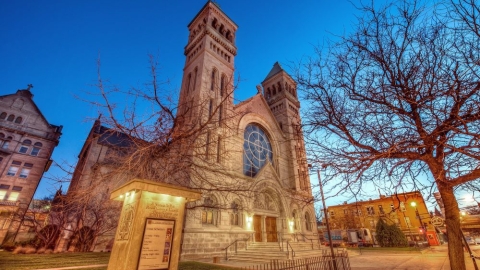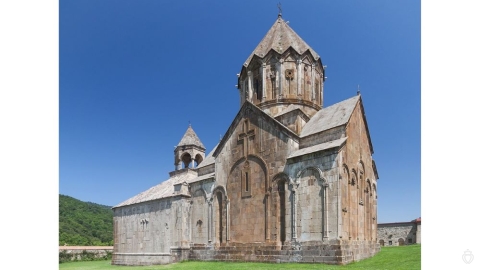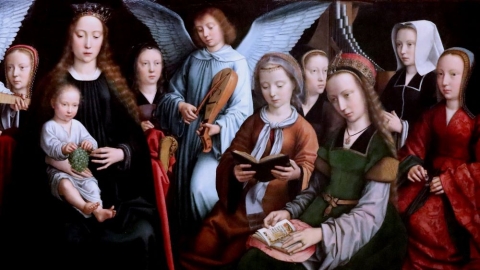The Holiness of the Church (2): The Apologetic Mark

Opening of the First Vatican Council
After having considered holiness as such, it is necessary to regard it as one of the marks of the Church. The term mark refers to philosophy: it means that a reality can be recognized as such thanks to the elements it contains and that it alone contains. The presence of this mark shows that we are dealing with the reality it designates.
Apologetics is a branch of theology that aims to allow a person of good will to approach the Catholic faith, eliminating the obstacles of false objections, and showing the coherence and beauty of Revelation brought by Christ, and the necessity of the Church in the plan of Redemption.
The Marks of the Church in Apologetics
According to the First Vatican Council, the true Church of Jesus Christ is recognizable by four “marks”: it must be one, holy, catholic, and apostolic.
This means that the holiness of the Church (as well as the other three marks), is not only a dogma deriving from revelation, as we saw in the first article, but that it must also be recognizable by those who do not believe, so that they can reasonably recognize as “credible” the claim of the Roman Church to be the Church of Jesus Christ.
However, how can holiness be recognized if one does not have faith? It would certainly be begging the question to relate it to what Jesus Christ revealed. It is therefore necessary to have recourse to the external manifestations of this holiness.
These manifestations exist at two levels: the holiness of the principles that the institution teaches and the holiness of its members. It must also be possible to ascertain that these characteristics belong exclusively to the institution which claims to be the true Church.
The Sacredness of Principles
True religion must possess principles of conduct which, when followed, lead men not only to an upright life, but also to a moral perfection which can flourish in the heroism of the virtues. It obviously cannot contain precepts contrary to natural law or right reason.
By therefore excluding pagan religions or Islam, which often contain precepts contrary to natural law itself (e.g., polygamy), even people without faith can easily recognize the superiority of the moral and spiritual principles contained in the Gospels.
Nothing in the Christian precepts, as proclaimed by the Church, can lead to the violation of natural law; everything leads to self-sacrifice and the heroic love of neighbor.
But it is up to us here to point out that these principles of Christian morality retain all their force in the Roman Church alone. Protestantism has led to the devaluing of works, to absolutizing conscience, and to yielding to the demands of the times. As for the separated Eastern churches, they have yielded for centuries on the indissolubility of marriage.
The modernism that undermines the principles of perfection of Christianity handed down in the Roman Church must be seen for what it is: a departure from authentic Catholic doctrine, which remains resplendent in the traditional teaching of the pontiffs of the past. This is the doctrine to which we refer and which remains the proof of the holiness of the Church.

Pope Pius IX
The Holiness of the Members
We have seen that, in accordance with the Gospels, the Roman Church has never claimed to be composed solely of saints. She claims that those who follow her teachings can become saints.
This holiness can be understood in three ways:
– common holiness: by observing the commandments and discipline of the Church, with the help of the sacraments and Catholic instruction, many men have been and still are able to live with dignity, without serious falls or at least by finding the means to recover from them, by maintaining a sincere desire for an honest and virtuous life.
– a more perfect holiness: which is that of those who undertake to live the three evangelical counsels of poverty, chastity, and obedience, renouncing material goods and the pleasures of the senses, and even their own will. The Church places many institutions endowed with sure rules for the pursuit of such a lofty ideal at the disposal of those who wish to follow the path of perfection.
Catholic asceticism, unlike Buddhist asceticism (for example), does not aim at the destruction of the individual, but at his fulfillment through virtue.
– Heroic holiness: the true heroism of the virtues, in the balance of these, which excludes pride and recklessness, of which martyrdom is the most striking example, and which has always flourished in the Roman Church, is not only exclusive to it, but also the fruit of the principles that belong to it. This is the greatest sign of her divinely-originated holiness, and will be the first subject of this series of articles.
The Catholic Church, with her cult of the saints, promotes the dissemination of these lofty models, which she first subjects to scrutiny, unique in its kind. Wherever the Church has spread, there are men and women who are eminent in their virtues, easily recognized even by those who do not believe.
With the presence of an authority which watches over supernatural gifts and phenomena, as well as the zeal and exercise of virtue itself, the Roman Church directs the saints during their lives and preserves them from enormous dangers, starting with pride.
Does Holiness Exist Outside the Roman Church?
Without going too far here, and remembering that we have already given a negative theological answer in the previous article, we must examine the claim to holiness of certain members of separated groups, especially Eastern ones.
The impossibility of being holy by following religions which deny the very rationality of natural law has already been mentioned; this excludes the Protestant world, which denies the very possibility of holiness, and which, moreover, has hardly produced any great religious figures.
The Orthodox world, on the other hand, canonizes its own saints. We are talking here about characters for whom heroic holiness is claimed, because common holiness has, in apologetics, only an indicative rather than a demonstrative value.
Starting from the fact that the canonizations made by the Orthodox hierarchy are not recognized by the Catholic Church, and that they are based rather on the observation of miracles or the incorruption of the body, the rare cases where a heroic holiness appears (especially in certain martyrs) are to be put down to an effect of the Catholic principles of holiness which still exist in these groups, especially among simple people or people of good faith.
In general, rather than belonging to such sects, these people testify at most to the holiness of what they have retained of the doctrine of Christ.
A similar discourse could be held for the traces of holiness found in those who attend the New Mass or follow a clergy imbued with modernist principles. The residual traces of Catholic doctrine are the only elements still capable of promoting holiness, and they bear witness to its integrity
Indeed, we do not know of any saints who have become saints by thinking that Christ is only an example of a religious experience comparable to many others, nor by assuming the worldly spirit that emanates from the new liturgy, nor by fighting for the good of “Mother Earth.” In truth, it seems unthinkable that this kind of approach would produce little more than philanthropists or social agitators.
Heroic holiness remains of another order.
Related links
(Source : DTC - FSSPX.Actualités)
Illustration 1 : Banque d’images Alamy
Illustration 2 : Adolphe Braun, Domaine public, via Wikimedia Commons





